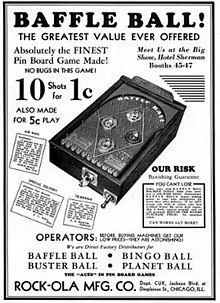 | |
| Manufacturer | D. Gottlieb & Co. |
|---|---|
| Release date | 1931 |
| Design | David Gottlieb |
| Production run | > 50,000 |
Baffle Ball is a pinball machine created on November 19, 1931, by David Gottlieb, founder of the Gottlieb amusement company.
 | |
| Manufacturer | D. Gottlieb & Co. |
|---|---|
| Release date | 1931 |
| Design | David Gottlieb |
| Production run | > 50,000 |
Baffle Ball is a pinball machine created on November 19, 1931, by David Gottlieb, founder of the Gottlieb amusement company.
For one US cent players get ten balls. These balls are fired up onto the playfield and fall into pockets and holes. Some ball targets are worth more than others, and players try to fire the ball at just the right speed. Unlike later pinball machines, Baffle Ball does not have flippers. The best target is the Baffle Ball at the top which doubles all points. The game uses no electricity, and all scoring has to be done by hand.
While bagatelle-derived "marble games" have long existed previously, Baffle Ball was the first commercially successful game of its type, being affordable enough for store and tavern owners to quickly recoup the machine's cost. Over 50,000 machines were made, jump-starting the arcade pinball field; it spawned a home version in 1932 called Baffle Ball Senior. [1]
Baffle Ball was responsible for the launch of the company Gottlieb that went on to make pinball machines such as Ace High and Black Hole . The game sat on top of bar counters and the bartender might award prizes for high scores. [2] It is very popular with and sought after by collectors. [2]
The table was virtually recreated in pinball simulation video game, Microsoft Pinball Arcade , although adjustments were made to the game rules. Instead of the normal silver balls, colored balls, that matches the color of the target, are played. Extra points are awarded if the player lands the ball in the target that exactly matches the color of the ball.
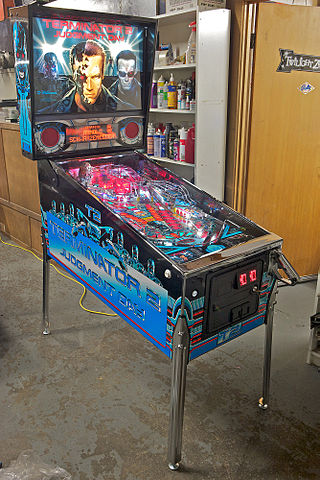
Pinball games are a family of games in which a ball is propelled into a specially designed table where it bounces off various obstacles, scoring points either en route or when it comes to rest. Historically the board was studded with nails called 'pins' and had hollows or pockets which scored points if the ball came to rest in them. Today, pinball is most commonly an arcade game in which the ball is fired into a specially designed cabinet known as a pinball machine, hitting various lights, bumpers, ramps, and other targets depending on its design. The game's object is generally to score as many points as possible by hitting these targets and making various shots with flippers before the ball is lost. Most pinball machines use one ball per turn, and the game ends when the ball(s) from the last turn are lost. The biggest pinball machine manufacturers historically include Bally Manufacturing, Gottlieb, Williams Electronics and Stern Pinball.
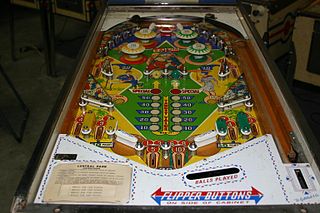
Gottlieb was an American arcade game corporation based in Chicago, Illinois. It is best known for creating a vast line of pinball machines and arcade games throughout much of the 20th century.

Rollerball is a video game produced by HAL Laboratory in 1984 for the MSX. A Nintendo Entertainment System version of the game was released in 1988. It is designed to be played by one to four players, in turn. It is an emulation of a pinball machine.
A glossary of terms, commonly used in discussing pinball machines.

Medieval Madness is a Williams pinball machine released in June 1997. Designed by Brian Eddy and programmed by Lyman Sheats, it had a production run of 4,016 units. As of April 3, 2022, the Pinside pinball community lists it as the #2 highest-ranked pinball machine ; many adherents consider it the greatest of all time.
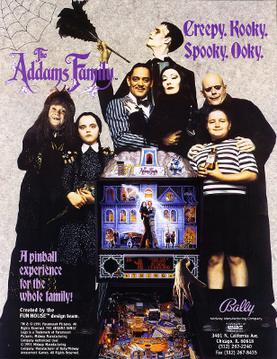
The Addams Family is a pinball machine released in March 1992. It was designed by Pat Lawlor and Larry DeMar and released by Midway. It was based on the 1991 film of the same name, and features custom speech by the stars of the film, Anjelica Huston and Raul Julia. It is the best-selling solid state pinball machine of all time with 20,270 units sold.

Black Hole is a pinball game released in 1981 by Gottlieb. It is notable for having two playfields: one on top with a conventional slope, and one mounted underneath, sloping away from the player. It has no connection with the 1979 film of the same name.
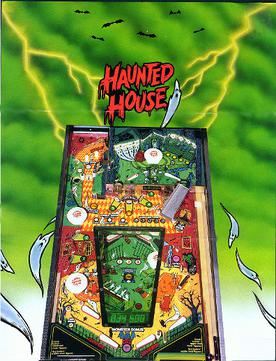
Haunted House is a pinball game released in October 31 1982 by Gottlieb. It was the first game with three playfields that the ball can move between, including one below the main playing surface. Haunted House was designed by John Osborne, with artwork by Terry Doerzaph. It is part of Gottlieb’s “System 80” series of pinball machines.

Star Trek: The Next Generation is a widebody pinball game, designed by Steve Ritchie and released in November 1993 by Williams Electronics. It was part of WMS' SuperPin series, and was based on the TV series. It is the only pinball machine that features three separate highscore-lists. Apart from the regular highscore-list and the buy-in-list, it also features a reminiscence to The Machine: Bride of Pin*Bot billionaires club. It is also the third pinball game overall based on the Star Trek franchise, following the 1979 pinball game by Bally, and the 1991 game by Data East, and preceding the 2013 pinball game by Stern.
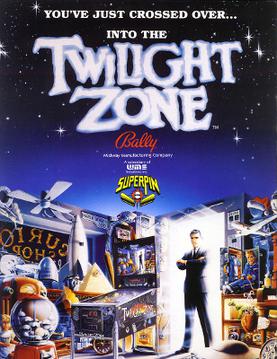
Twilight Zone is a widebody pinball machine, designed by Pat Lawlor and based on the TV series of the same name. It was first released in 1993 by Midway. This game is part of WMS' SuperPin line of widebody games alongside Star Trek: The Next Generation and Indiana Jones: The Pinball Adventure.

Cirqus Voltaire is a 1997 pinball game, designed by John Popadiuk and released by Williams Electronics Games. The theme involves the player performing many different marvels in order to join the circus. Some of the game's distinctive features include a neon light running along the right-hand ramp, a pop bumper that rises up from the middle of the playfield at certain times, and a magnet at the top of the left ramp that can catch balls and divert them into the locks. The most notable feature is the Ringmaster, a head that rises at certain times and taunts the player.
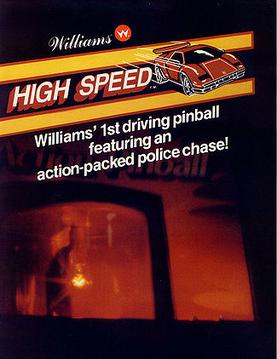
High Speed is a pinball game designed by Steve Ritchie and released by Williams Electronics in 1986. It is based on Ritchie's real-life police chase inside a 1979 Porsche 928. He was finally caught in Lodi, California on Interstate 5 and accused of speeding at 146 miles per hour (235 km/h).
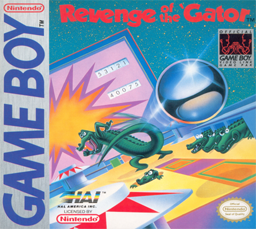
Revenge of the 'Gator, known in Europe as Pinball: Revenge of the 'Gator, is an alligator-themed pinball video game developed and published by HAL Laboratory. It was released for the original Game Boy in 1989/1990. The objective of the game is to score as many points as possible without having the player's pinball eaten by the gator.
Doctor Who is a pinball machine designed by Bill Pfutzenreuter (Pfutz) and Barry Oursler, and released by Midway in September 1992. It is based on the television series Doctor Who. As stated in the Gameplay section, the rulesheet is rather different from other pinball machines released at the time, which didn't help popularity as casual players did not understand the complex rule changes that occur during the game.
"300" is a pinball machine designed by Ed Krynski and produced by Gottlieb with a bowling theme. The title is a reference to a perfect game in the sport, in which a bowler scores 300 points. A two-player version of this four-player game was released as Top Score.

Jack-Bot is a 1995 pinball game which was designed by Barry Oursler and Larry DeMar, and released by Williams. It is the third game in the Pin-Bot series, following Pin-Bot (1986) and The Machine: Bride of Pin-Bot (1991).
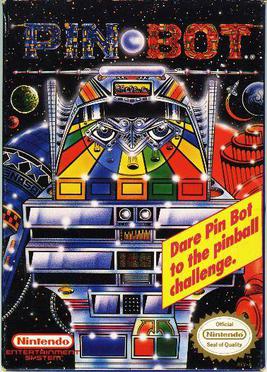
Pin Bot is a pinball video game developed by Rare and published by Nintendo for the Nintendo Entertainment System. It was released in North America in April 1990. It is a conversion of the pinball machine by the same name. The NES version of the game accurately reproduces some of the game-play and aesthetics of the pinball machine, while introducing new features and added challenges.

Central Park is a pinball machine that was released by Gottlieb in 1966. The game was sold in 3,100 units. It was designed by Ed Krynski and the art was done by Roy Parker.

Tee'd Off is a pinball machine designed by Ray Tanzer and Jon Norris and released by Gottlieb in May 1993.

Genie is a widebody pinball machine designed by Ed Krynski and released in 1979 by Gottlieb. It features a jinn theme and was advertised with the slogans "Gottlieb's WIDE and Beautiful BODY" and "A Wide-Body Pinball absolutely bulging with player appeal and proven massive profit earning capacity!".